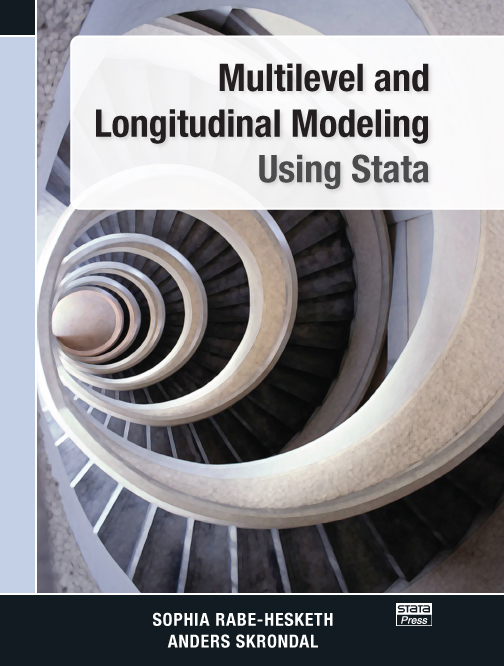书名:multilevel and longitudinal modeling using stata
版本:第二版
来源:网友扫描,委托上传
格式:扫描pdf+ocr
大小:19m
说明:本书正是此前eblog版主悬赏过的,当时我上传了第一版,此次上传的是第二版。
本书设置两个价格,扫描该书的网友不方便上网,委托我上传,由出售帖的到的金钱达3000后,出售帖的价格将改为象征性的1金钱。二楼的出售帖内容与本帖一样,但是给论坛里金钱较多的版友一个捐赠的机会,你们一人捐赠后出售帖价格将改为象征性的1金钱。

Table of contents
1 Linear variance-components models
1.1 Introduction
1.2 How reliable are expiratory flow measurements?
1.3 The variance-components model
1.3.1 Model specification and path diagram
1.3.2 Error components, variance components, and reliability
1.3.3 Intraclass correlation
1.4 Modeling the Mini Wright measurements
1.4.1 Estimation using xtreg
1.4.2 Estimation using xtmixed
1.4.3 Estimation using gllamm
1.4.4 Relative and absolute agreement
1.5 Estimation methods
1.6 Assigning values to the random intercepts
1.6.1 Maximum likelihood estimation
Implementation via OLS regression
Implementation via the mean total residual
1.6.2 Empirical Bayes prediction
1.6.3 Empirical Bayes variances
1.7 Summary and further reading
1.8 Exercises
2 Linear random-intercept models
2.1 Introduction
2.2 Are tax preparers useful?
2.3 The longitudinal data structure
2.4 Panel data and correlated residuals
2.5 The random-intercept model
2.5.1 Estimation using xtreg
2.5.2 Estimation using xtmixed
2.6 Different kinds of effects in panel models
2.6.1 Between-taxpayer effects
2.6.2 Within-taxpayer effects
2.6.3 Relations among the estimators
2.7 Endogeneity and between-taxpayer effects
2.8 Residual diagnostics
2.9 Summary and further reading
2.10 Exercises
3 Linear random-coefficient and growth-curve models
3.1 Introduction
3.2 How effective are different schools?
3.3 Separate linear regressions for each school
3.4 The random-coefficient model
3.4.1 Specification and interpretation of a random-coefficient model
3.4.2 Estimation and prediction using xtmixed
Estimation of random-intercept model
Estimation of random-coefficient model
Empirical Bayes prediction using xtmixed
3.4.3 Estimation and prediction using gllamm
Estimation of random-intercept model
Estimation of random-coefficient model
Empirical Bayes prediction
3.5 How do children grow?
3.6 Growth-curve modeling
3.6.1 Observed growth trajectories
3.6.2 Estimation using xtmixed
Quadratic growth model with random intercept
Quadratic growth model with random intercept and random slope
Including a child-level covariate
3.6.3 Estimation using gllamm
Quadratic growth model with random intercept
Quadratic growth model with random intercept and random slope
Including a child-level covariate
3.7 Two-stage model formulation
3.7.1 Model specification
3.7.2 Estimation
3.8 Prediction of trajectories for individual children
3.9 Complex level-1 variation or heteroskedasticity
3.10 Summary and further reading
3.11 Exercises
4 Dichotomous or binary responses
4.1 Models for dichotomous responses
4.1.1 Generalized linear model formulation
4.1.2 Latent-response formulation
Logistic regression
Probit regression
4.2 Which treatment is best for toenail infection?
4.3 The longitudinal data structure
4.4 Population-averaged or marginal probabilities
4.5 Random-intercept logistic regression
4.6 Subject-specific vs. population-averaged relationships
4.7 Maximum likelihood estimation using adaptive quadrature
4.7.1 Some practical considerations
4.8 Empirical Bayes (EB) predictions
4.8.1 EB prediction of random effects
4.8.2 EB prediction of response probabilities
4.9 Other approaches to clustered dichotomous data
4.9.1 Conditional logistic regression
4.9.2 Generalized estimating equations (GEE)
4.10 Summary and further reading
4.11 Exercises
5 Ordinal responses
5.1 Introduction
5.2 Cumulative models for ordinal responses
5.2.1 Generalized linear model formulation
5.2.2 Latent-response formulation
5.2.3 Proportional odds
5.2.4 Identification
5.3 Are antipsychotic drugs effective for patients with schizophrenia?
5.4 Longitudinal data structure and graphs
5.4.1 The longitudinal data structure
5.4.2 Plotting cumulative proportions
5.4.3 Plotting cumulative logits and transforming the time scale
5.5 A proportional-odds model
5.5.1 Model specification
5.5.2 Estimation
5.6 A random-intercept proportional-odds model
5.6.1 Model specification
5.6.2 Estimation
5.7 A random-coefficient proportional-odds model
5.7.1 Model specification
5.7.2 Estimation
5.8 Marginal and patient-specific probabilities
5.8.1 Marginal probabilities
5.8.2 Patient-specific cumulative response probabilities
5.9 Do experts differ in their grading of student essays?
5.10 A random-intercept model with grader bias
5.10.1 Model specification
5.10.2 Estimation
5.11 Including grader-specific measurement error variances
5.11.1 Model specification
5.11.2 Estimation
5.12 Including grader-specific thresholds
5.12.1 Model specification
5.12.2 Estimation
5.13 Summary and further reading
5.14 Exercises
6 Counts
6.1 Introduction
6.2 Types of counts
6.3 Poisson model for counts
6.4 Did the German health-care reform reduce the number of doctor visits?
6.5 Longitudinal data structure
6.6 Poisson regression ignoring overdispersion and clustering
6.6.1 Model specification
6.6.2 Estimation
6.7 Poisson regression with overdispersion but ignoring clustering
6.7.1 Using a level-1 random intercept
Model specification
Estimation
6.7.2 Quasilikelihood
Specification
Estimation
6.8 Random-intercept Poisson regression
6.8.1 Model specification
6.8.2 Estimation
6.9 Random-coefficient Poisson regression
6.9.1 Model specification
6.9.2 Estimation
6.10 Other approaches to clustered counts
6.10.1 Conditional Poisson regression
6.10.2 Generalized estimating equations (GEE)
6.11 Which Scottish countries have a high risk of lip cancer?
6.12 Standardized mortality ratios
6.13 Random-intercept Poisson regression
6.13.1 Model specification
6.13.2 Estimation
6.13.3 Introducing a county-level covariate
6.13.4 Prediction
6.14 Nonparametric maximum likelihood estimation
6.14.1 Specification
6.14.2 Estimation
6.14.3 Prediction
6.15 Summary and further reading
6.16 Exercises
7 Higher level models and nested random effects
7.1 Introduction
7.2 Which method is best for measuring expiratory flow?
7.3 Two-level variance-components models
7.3.1 Model specification
7.3.2 Estimation
7.4 Three-level variance-components models
7.4.1 Model specification
7.4.2 Different types of intraclass correlation
7.4.3 Three-stage formulation
7.4.4 Estimation using xtmixed
7.4.5 Prediction using xtmixed
7.5 Did the Guatemalan immunization campaign work?
7.6 A three-level logistic random-intercept model
7.6.1 Model specification
7.6.2 Different types of intraclass correlations for the latent responses
7.6.3 Three-stage formulation
7.6.4 Estimation
7.6.5 Introducing a random coefficient at level 3
7.6.6 Prediction
7.7 Summary and further reading
7.8 Exercises
8 Crossed random effects
8.1 Introduction
8.2 How does investment depend on expected profit and capital stock?
8.3 A two-way error-components model
8.3.1 Model specification
8.3.2 Intraclass correlations
8.3.3 Estimation
8.3.4 Prediction
8.4 How much do primary and secondary schools affect attainment at age 16?
8.5 An additive crossed random-effects model
8.5.1 Specification
8.5.2 Estimation
8.6 Including a random interaction
8.6.1 Model specification
8.6.2 Intraclass correlations
8.6.3 Estimation
8.6.4 Some diagnostics
8.7 A trick requiring fewer random effects
8.8 Summary and further reading
8.9 Exercises
A Syntax for gllamm, eq, and gllapred
B Syntax for gllamm
C Syntax for gllapred
D Syntax for gllasim
References
[此贴子已经被wesker1999于2008-11-26 1:23:30编辑过]

 扫码加好友,拉您进群
扫码加好友,拉您进群